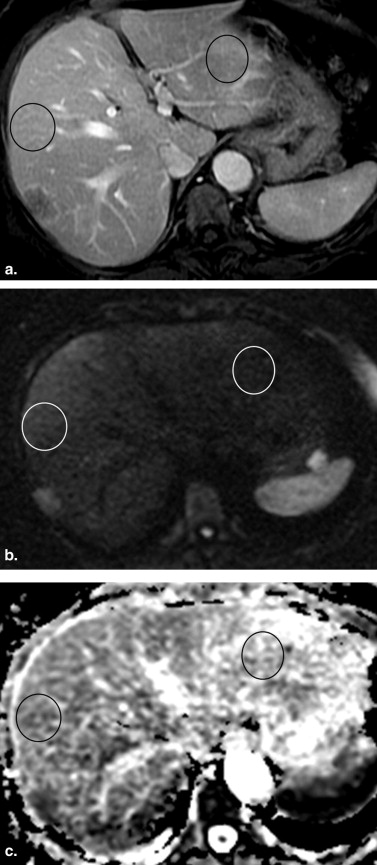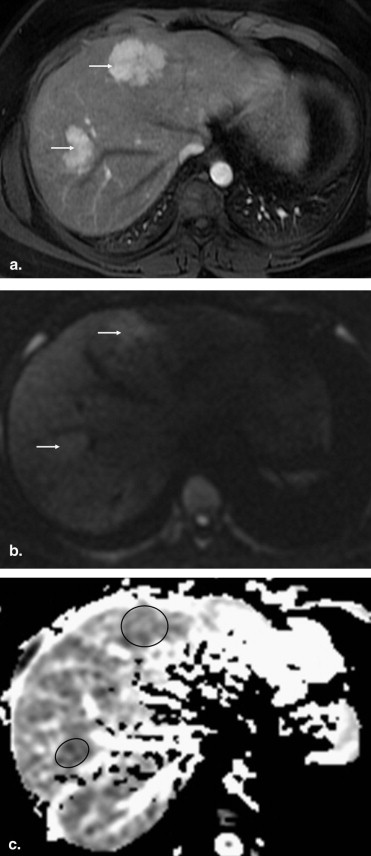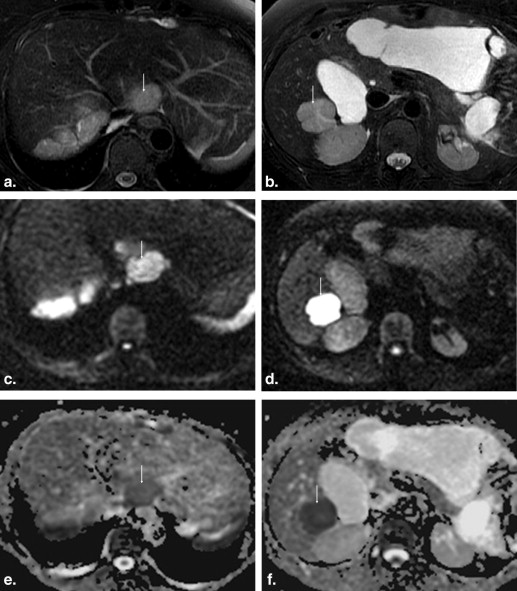Rationale and Objectives
To determine possible differences between the left and right hepatic lobes in apparent diffusion coefficient (ADC) values of benign and malignant focal liver lesions (FLLs) and normal liver parenchyma.
Materials and Methods
Thirty-six patients (16 males, 20 females; mean age 56.8 years) with FLLs of the same etiology in both the left and right hepatic lobes (13 patients with 26 benign FLLs and 23 patients with 46 malignant FLLs) who underwent 1.5T magnetic resonance imaging (MRI) including diffusion-weighted MRI (b values: 0 and 800 seconds/mm) with respiratory gating and without cardiac gating were included in this Health Insurance Portability and Accountability Act–compliant and institutional review board–approved study. ADC values of normal liver parenchyma and FLLs in each hepatic lobe were calculated and compared by using Student’s t -test and Wilcoxon signed-rank test, respectively.
Results
The mean ADC values of normal liver parenchyma, benign FLLs, and malignant FLLs were significantly higher ( P < .001, P = .003, and P = .005, respectively) in the left hepatic lobe (1.74 × 10 −3 , 1.81 × 10 −3 , and 1.48 × 10 −3 mm²/second, respectively) than in the right hepatic lobe (1.48 × 10 −3 , 1.54 × 10 −3 , and 1.24 × 10 −3 mm²/second, respectively).
Conclusion
ADC values of benign and malignant FLLs calculated from noncardiac-gated DW-MRI are significantly higher in the left hepatic lobe compared with the right hepatic lobe. This may be a limitation for characterization of FLLs based on ADC measurements.
Diffusion-weighted magnetic resonance imaging (DW-MRI) is used increasingly for the detection and characterization of focal liver lesions (FLLs). The apparent diffusion coefficient (ADC) value provides quantitative characterization of these lesions and is thought to help the differentiation between benign and malignant FLLs. In general, benign FLLs have higher ADC values than malignant FLLs, but there are also variable degrees of overlap between them . Several cutoff ADC values (1.4–1.6 × 10 −3 mm²/second) have been suggested in the literature for differentiating malignant from benign FLLs, with reported sensitivity of 74% to 100% and specificity of 77% to 100% .
Despite widespread clinical use of such advanced MRI techniques as ultrafast and single-shot or multishot echoplanar imaging, multichannel coil, and parallel imaging , however, DW-MRI in the abdomen is still known to be highly sensitive to motion. Several studies have documented that cardiac motion has an impact on DW-MRI of the abdomen, resulting in higher ADC values of normal liver parenchyma in the left hepatic lobe compared with the right hepatic lobe . Therefore, the ADC values of FLLs in the left hepatic lobe may be expected also to be higher than those in the right hepatic lobe. Variations in ADC values of FLLs because of their location in the liver may thus represent an important limitation of DW-MRI and potentially impact the usefulness of DW-MRI for characterizing FLLs. The purpose of this study was to determine whether ADC values of benign and malignant FLLs, calculated from noncardiac-gated DW-MRI, are different in the left and right hepatic lobes.
Materials and methods
Get Radiology Tree app to read full this article<
MRI
Get Radiology Tree app to read full this article<
Reference Standard
Get Radiology Tree app to read full this article<
Get Radiology Tree app to read full this article<
Quantitative Analysis
Get Radiology Tree app to read full this article<
Get Radiology Tree app to read full this article<
Statistical Analysis
Get Radiology Tree app to read full this article<
Results
Reference Standard
Get Radiology Tree app to read full this article<
Table 1
Type of Lesions
Benign Lesions ∗ Malignant Lesions ∗ Hemangioma ( n = 18)
Focal nodular hyperplasia ( n = 6)
Adenoma ( n = 2) 34 metastases ( n = 43) (Primary: adenocarcinoma of the pancreas: n = 4; neuroendocrine tumor: n = 2; carcinoid: n = 2; colorectal adenocarcinoma: n = 2; ovarian cancer: n = 1; renal cell carcinoma: n = 1; breast cancer: n = 1, lung cancer: n = 1; esophageal cancer: n = 1)
Hepatocellular carcinoma ( n = 12)
Get Radiology Tree app to read full this article<
Get Radiology Tree app to read full this article<
Evaluation of Normal Liver Parenchyma
Get Radiology Tree app to read full this article<
Table 2
Comparison of ROI Size for Calculation of ADC Values between the Left and Right Hepatic Lobes
Mean ± SD in ROI Size (mm²)P Value (Using Mann-Whitney Rank Sum Test) Left Hepatic Lobe Right Hepatic Lobe Normal liver parenchyma 742.02 ± 483.49 972.47 ± 619.30 .379 FLL 369.72 ± 654.10 356.8 ± 415.40 .477
ADC, apparent diffusion coefficient; FLL, focal liver lesions; ROI, region of interest; SD, standard deviation.
Table 3
Comparison of ADC Values between the Left and Right Hepatic Lobes and between Benign and Malignant FLLs
Mean ± SD ADC Values (10 −3 mm²/second)P Value (Using Mann-Whitney Rank Sum Test ∗ and Unpaired t -Test, Respectively) Left Hepatic Lobe Right Hepatic Lobe Normal liver parenchyma 1.78 ± 0.28 1.48 ± 0.27 <.001 FLLs Benign 1.81 ± 0.25 1.54 ± 0.19 .003 Malignant 1.48 ± 0.31 1.24 ± 0.26 .005P value <.001 <.001
ADC, apparent diffusion coefficient; FLL, focal liver lesions; SD, standard deviation.
Get Radiology Tree app to read full this article<
Evaluation of FLLs
Get Radiology Tree app to read full this article<
Get Radiology Tree app to read full this article<
Discussion
Get Radiology Tree app to read full this article<
Get Radiology Tree app to read full this article<
Get Radiology Tree app to read full this article<
Get Radiology Tree app to read full this article<
Get Radiology Tree app to read full this article<
References
1. Taouli B., Vilgrain V., Dumont E., et. al.: Evaluation of liver diffusion isotropy and characterization of focal hepatic lesions with two single-shot echo-planar MR imaging sequences: prospective study in 66 patients. Radiology 2003; 226: pp. 71-78.
2. Yamada I., Aung W., Himeno Y., et. al.: Diffusion coefficients in abdominal organs and hepatic lesions: evaluation with intravoxel incoherent motion echo-planar MR imaging. Radiology 1999; 201: pp. 617-623.
3. Ichikawa T., Haradome H., Hachiya J., et. al.: Diffusion-weighted MR imaging with a single-shot echo-planar sequence: detection and characterization of focal hepatic lesions. AJR Am J Roentgenol 1998; 170: pp. 397-402.
4. Kim T., Murakami T., Takahashi S., et. al.: Diffusion-weighted single-shot echoplanar MR imaging for liver disease. AJR Am J Roentgenol 1999; 173: pp. 393-398.
5. Bruegel M., Holzapfel K., Gaa J., et. al.: Characterization of focal liver lesions by ADC measurements using a respiratory triggered diffusion-weighted single-shot echo-planar MR imaging technique. Eur Radiol 2008; 18: pp. 477-485.
6. Bruegel M., Gaa J., Waldt S., et. al.: Diagnosis of hepatic metastasis: comparison of respiration-triggered diffusion-weighted echo-planar MRI and five T2-weighted turbo spin-echo sequences. AJR Am J Roentgenol 2008; 191: pp. 1421-1429.
7. Gourtsoyianni S., Papanikolaou N., Yarmenitis S., et. al.: Respiratory gated diffusion-weighted imaging of the liver: value of apparent diffusion coefficient measurements in the differentiation between most commonly encountered benign and malignant focal liver lesions. Eur Radiol 2008; 18: pp. 486-492.
8. Parikh T., Drew S.J., Lee V.S., et. al.: Focal liver lesion detection and characterization with diffusion-weighted MR imaging: comparison with standard breath-hold-T2-weighted imaging. Radiology 2008; 246: pp. 812-822.
9. Mueller M.F., Prasad P., Siewert B., et. al.: Abdominal diffusion mapping with use of a whole-body echo-planar system. Diagn Interv Radiol 2007; 13: pp. 81-86.
10. Demir O.I., Obuz F., Sagol O., et. al.: Contribution of diffusion-weighted MRI to the differential diagnosis of hepatic metastases. Diagn Interv Radiol 2007; 13: pp. 81-86.
11. Vossen J.A., Bujis M., Liapi E., et. al.: Receiver operating characteristic analysis of diffusion-weighted magnetic resonance imaging in differentiating hepatic hemangioma from other hypervascular liver lesions. J Comput Assist Tomogr 2008; 32: pp. 750-756.
12. Taouli B., Koh D.M.: Diffusion-weighted MR imaging of the liver. Radiology 2010; 254: pp. 47-66.
13. Naganawa S., Kawai H., Fukatsu H., et. al.: Diffusion-weighted imaging of the liver: technical challenges and prospects for the future. Magn Reson Med Sci 2005; 31: pp. 175-186.
14. Dietrich O., Biffar A., Baur-Melnyk A., et. al.: Technical aspects of MR diffusion imaging of the body. Eur Radiol 2010; 76: pp. 314-322.
15. Kwee T., Takahara T., Niwa T., et. al.: Influence of cardiac motion on diffusion-weighted magnetic resonance imaging of the liver. MAGMA 2009; 22: pp. 319-325.
16. Mürtz P., Flacke S., Träber F., et. al.: Abdomen: diffusion-weighted MR Imaging with pulse-triggered single-shot sequences. Radiology 2002; 224: pp. 258-264.
17. Nasu K., Kuroki Y., Sekiguchi R., et. al.: Measurement of the apparent diffusion coefficient in the liver: is it a reliable index for hepatic disease diagnosis?. Radiat Med 2006; 24: pp. 438-444.
18. Kandpal H., Sharma R., Madhusudhan K.S., et. al.: Respiratory-triggered versus breath-hold diffusion-weighted MRI of liver lesions: comparison of image quality and apparent diffusion coefficient values. AJR Am J Roentgenol 2009; 192: pp. 915-922.
19. Kiliçkesmez Ö., Yirik G., Bayaramoğlu S., et. al.: Non-breath-hold high b-value diffusion-weighted MRI with parallel imaging technique: apparent diffusion coefficient determination in normal abdominal organs. Diagn Interv Radiol 2008; 14: pp. 83-87.
20. Semelka R.C., Brown E.D., Ascher S.M., et. al.: Hepatic hemangiomas: a multi-institutional study of appearance on T2-weighted and serial gadolinium-enhanced gradient-echo MR images. Radiology 1994; 192: pp. 401-406.
21. Hussain S.M., Terkivatan T., Zondervan P.E., et. al.: Focal nodular hyperplasia: findings at state-of-the-art MR imaging, US, CT, and pathologic analysis. RadioGraphics 2004; 24: pp. 3-17.
22. Vilgrain V., Flejou J.F., Arrive L., et. al.: Focal nodular hyperplasia of the liver: MR imaging and pathologic correlation in 37 patients. Radiology 1992; 184: pp. 664-703.
23. Arrive L., Flejou J.F., Vilgrain V., et. al.: Hepatic adenoma: MR findings in 51 pathologically proved lesions. Radiology 1994; 193: pp. 507-512.
24. Mortele K.J., Praet M., Van Vlierberghe H., et. al.: Focal nodular hyperplasia of the liver: detection and characterization with plain and dynamic-enhanced MRI. Abdom Imaging 2002; 27: pp. 700-707.
25. Earls J.P., Theise N.D., Weinreb J.C., et. al.: Dysplastic nodules and hepatocellular carcinoma: thin-section MR imaging of explanted cirrhotic livers with pathologic correlation. Radiology 1996; 201: pp. 207-214.
26. Krinsky G.A., Lee V.S., Theise N.D., et. al.: Hepatocellular carcinoma and dysplastic nodules in patients with cirrhosis: prospective diagnosis with MR imaging and explantation correlation. Radiology 2001; 219: pp. 445-454.
27. Danet I.M., Semelka R.C., Leonardou P., et. al.: Spectrum of MRI appearances of untreated metastases of the liver. AJR Am J Roentgenol 2003; 181: pp. 809-817.
28. Bruix J., Sherman M.: Management of hepatocellular carcinoma. AASLD Practice Guideline. Hepatology 2005; 42: pp. 1209-1236.
29. Bruix J., Sherman M.: AASLD Practice guideline: management of hepatocellular carcinoma: an update. Hepatology 2011; 53: pp. 1020-1022.
30. Sandrasegeran K., Akisik F.M., Lin C., et. al.: Value of diffusion-weighted MRI for assessing liver fibrosis and cirrhosis. AJR Am J Roentgenol 2009; 193: pp. 1556-1560.


